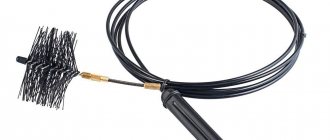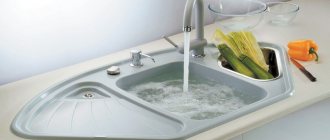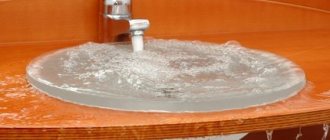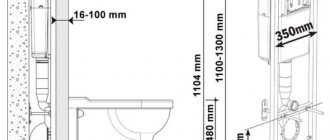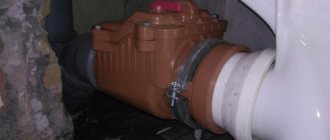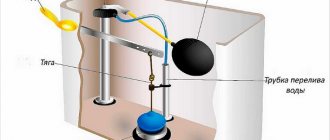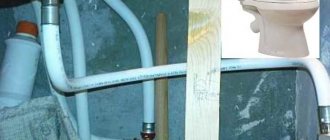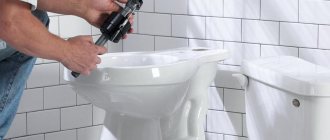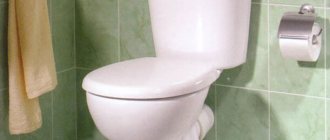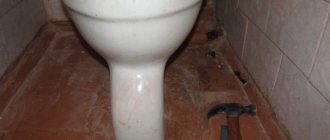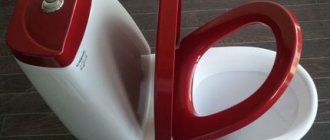When faced with a situation where the water in the toilet does not drain and rises even higher when flushed again, we grab the plunger, trying to remove the blockage. However, this does not always work out if the blockage is deep with a large accumulation of debris, a more radical and effective remedy is needed, such as a plumbing cable for cleaning the toilet.
Even when the chemical industry offers a large range of toilet cleaning products, Domestos, mole and others, there is no better way to remove a severe clog than torso.
A modern cable for cleaning plastic sewer pipes consists of a metal wire in the form of a spiral, which is covered with a vinyl chloride sheath to prevent damage to plastic pipes by the cable.
The length of the cable usually does not exceed 5-6 meters, which is quite enough to break through the sewer along the entire length of the pipes in a separate apartment. The diameter of the cable varies from 6 to 12 mm. When choosing a cable, take into account that the cable must be an order of magnitude narrower than the pipe into which it is lowered to prevent damage. This makes it easier to pass and prevents damage to the pipes.
The cable allows you to reach the most remote parts of the sewer, passing through the bends and joints of various pipes, while easily twisting, without taking up much space on the shelf in the apartment.
Although the cable is a device for cleaning the toilet, it is important to master the correct stages of working with it, otherwise you will not achieve the desired effect.
Time-tested benefits
The modern market is flooded with various means and devices designed to counteract blockages, but for many years the most effective and popular means for eliminating this nuisance has been and remains a plumbing cable.
To make a cable, strong iron wire twisted into a spiral is much more often used. Some products have a plastic braid, which significantly reduces the possibility of pipe damage during operation. In addition, the distinctive feature of the cables is their different lengths (from 1 to twenty meters or even 30 m) and thickness - from 6 to 13 mm. Diameter is a very important parameter that must be taken into account when choosing a tool, since the cable must move freely into the pipes.
The main advantages are low price and compactness (the optimal storage method is a rolled form). In addition, the plumbing cable is very easy to use, and the help of an expert is not required. It is possible to use the cable for any type of communications and the most complex blockages. Not only a plumber, but also most practical people will definitely have such a tool.
Recommendations for the care and storage of the cable
Since the cable is not disposable equipment, it is worth familiarizing yourself with how to properly store it. After use, equipment must be thoroughly rinsed in hot water. It is appropriate to use detergents. A clean cable should be dried, coiled and stored in a dry place.
With proper care, a plumbing cable will help out for a long time in difficult situations. Moreover, such a cable can be used to clean ventilation and chimneys. You just need to purchase a suitable nozzle for this.
Types of cables
Depending on the purpose and complexity of the blockage, there are a couple of types of sewer cables.
Cable. The diameter of the tool is 6 mm; galvanized steel is used for manufacturing, and the optimal value does not exceed 5 meters (this is quite enough for apartment sewerage). The factory in most cases crimps the end of the cable, but it is practiced among plumbers to give it a brush shape, as this helps remove wool, hair and other clogs. This design is characterized by good characteristics, in particular, great strength, durability, excellent elasticity and flexibility. Thanks to these qualities, the cable passes freely into a pipe, bend or sewer joint. But there is also a significant disadvantage - the rope cable is too soft, which is why it is unlikely to be able to cope with an important blockage.
Flexible plumbing cable and flexible shaft or flexible hose. Such a device is much more ergonomic and efficient than a rope cable. The design is as follows: an iron spiral is wound on top of a steel core in 1 or a couple of layers. The permissible length of the product is 60 m, and the diameter is up to 28 mm.
Iron tape is also one of the types of plumbing cable. Available in a set with a tip and handle. The length of the product reaches up to thirty meters, and the width is up to 25 mm.
Spring-loaded. The length of this type of cable is 6 meters, and the diameter is 9 mm. In accordance with the category, it can be called household, and its design is based on a hollow steel spring.
Advice! If the diameter of the plumbing cable is 13.5 mm and the length is 25 meters, then it already has experienced equipment capable of cleaning a riser pipe or any other horizontal pipe.
Tension. The design of a plumbing spring cable is represented by a flexible shaft wrapped in spring-type wire. It was called tension due to the fact that as the handle turns, it becomes hard, like a rod. This tool is experienced because it can cope with complex blockages that were beyond the capabilities of a conventional cable. A special drum is used to carry and store all-metal and steel cables in vinyl braid.
Electric cables , which look like a whole installation from the outside, are used to clean sewer pipes of enormous diameter. The electric model looks like a cable from the outside, equipped with a pistol-type tip and handle, wound on a special drum. Such a tool is capable of clearing any pipe, even the most severe blockage.
The price of a plumbing cable for clearing sewer blockages is largely influenced by the model and the chosen manufacturer.
How to choose the right option
The principle of using a plumbing cable is extremely simple. First, the tool is pushed into the sewer pipe as far as it will go so that its end touches the blockage.
Then, through rotational and reciprocating movements with the handle of the tool, the tip of this end is used to pick up the plug in order to pull it out or destroy it in place inside the pipeline.
The specifics of application and efficiency of use depend on the design of the cable and the correct choice of tool size.
Taking into account the design features of different models
There are four types of plumbing cables sold in hardware stores:
- rope - a classic thin rope (rod) made of several wires;
- spring - a hollow spring twisted from wire;
- spring-wound - a flexible core with a spiral wound on the outside;
- tape (flat) - tape 1–4 cm wide.
For all types of plumbing cable, the working elements (handles, nozzles, tapes, wires) are usually made of durable steel.
There are models in which the spiral is covered on the outside with a rubberized shell, which protects the inner walls of the pipes from mechanical damage from metal. But in most cases, a plumbing cable is just a steel spring without any braid.
Ropeway . A small cable 1.5–3 meters long belongs to the household category of tools. It is optimally suited for cleaning sinks, removing blockages in the toilet and on horizontal sections of pipelines up to the common riser.
It is pointless to try to “break through” a plug in the depths of the sewer. Such a plumbing rope will either not reach the blockage, or simply will not be able to destroy it.
Spring-loaded . The cable is small in size and ideal for cleaning indoor risers and sewer pipes leading to them from plumbing fixtures.
Core cable . This is a professional tool that can be used to push through a weed plug. It is difficult to do something similar with a regular spiral because of its greater softness and compressibility.
Ribbon . Such a tool is not flexible enough and cannot reach all corners of the sewer. It, unlike a spring, bends only in one plane. But the ribbon cable has smaller dimensions when twisted.
Most often it is used when cleaning long main pipes of large diameter, which have an order of magnitude fewer bends than those inside the house.
Determining the optimal working diameter
When purchasing a cable for cleaning sewer pipes, you need to choose its cross-section wisely. It is unlikely that you will be able to clean a sink or urinal with a tool that is too thick. It simply won't fit into the drain hole. This flexible shaft is designed for cleaning risers and wide pipes of large diameter.
Procedure for clearing the blockage
Before you start cleaning the pipe, you need to familiarize yourself with the features of a standard drain system. The drain hole is connected to a siphon or water seal. A siphon is a pipe that has a curved shape. Its main purpose is to block the unpleasant odor that is invariably present in the sewer system. The siphon is connected to a drain pipe, which in the future will connect to the main riser of the building. Such a complex design requires great care in its use, since sudden and thoughtless movements can cause damage to the drain system.
The procedure for using a plumbing cable:
- First you need to unwind the cable and very carefully insert it into the drain hole. The cable must be moved along the pipe until it hits the blockage. But you should not think that the first obstacle you encounter on the way is a blockage; much more often it is a sharp turn in the pipe or a joint. In order to check what kind of obstacle you got in your way, you must first pull out the cable a little, and then try, by rotating it, to push it through again. If the above movements do not produce any result, then the goal has been achieved - it is a blockage.
- Now it is necessary to try to destroy the structure of the plug and push it further along the pipe using a nozzle with a pointed end. Along with this, the tool must not only make reciprocating movements, but also rotate around its axis. This is done using a special handle. If warm water flows into the drain pipe at the same time, this will have a softening effect on the plug and will significantly speed up the cleaning process.
- When the cable begins to move freely in the pipe, carefully remove it and check how well the water drains. In order to get rid of debris accumulated on the walls of the pipes, it is recommended to rinse them for several minutes. a stream of warm water.
Types of sewer blockages
Understanding their nature is very important for proper selection of cables. Plumbing plugs differ in the reasons for their occurrence, and accordingly, their strength can also vary.
Plumbing plug in the knee
Operational blockage
An inevitable problem with any sewerage system. It occurs due to the fact that particles of food, grease, fabric, hair, wool, sand and other very small debris are washed into the kitchen sink, which accumulate on the walls of the pipes for months and years, forming dense plugs. To remove them, a thin cord will be enough, since such a blockage is called the simplest.
Mechanical plugs
They appear due to large solid objects or plastic bags flushed down the toilet, which become a wedge in the pipe, collecting the rest of the garbage. To remove such a blockage, it is necessary to use a powerful, thick drain cleaning cable, which will forcefully damage and push the stuck object. If the object is very durable, then the device will not be able to damage it, and you will have to:
- calculate the approximate location of the plug using the length of the cable;
- cut the pipe;
- physically remove it.
Technological blockage
It occurs as a natural process of deposition of solid fractions on pipes.
Technological sewer blockage
They have a very strong structure and are located almost along the entire length of the sewer pipe. Here, even a powerful cable is unlikely to help, except to temporarily make a hole for draining wastewater. This requires a complete replacement of the pipes.
How to clean a toilet using a cable
If the toilet is clogged, it is also recommended to use a plumbing cable. The principle of operation is extremely simple: the end of the cable must be inserted into the toilet, and then, using slow and gentle rotational movements, push it deep until it hits something. If the blockage is located in a pipe, the cable will rest against it. Then you need to try to do one of the following actions: either push the blockage forward, or hook it and pull it back using a special nozzle.
How to use the tool
- We will be working with hard metal, so strong assembly gloves are a must. Also dress in durable work clothes.
- If the tool comes with tips, use one of them according to the manufacturer's instructions.
- Do not unwind the entire sewer cable at once; it must be kept rolled into a ring and straightened only to the length of the immersion.
- Choose the direction of rotation with which you will move deeper. It must not be changed during the process to avoid the cable wedge.
- When the cable hits a dead end, it will become more difficult to turn it. You will have to work hard, maybe even take it out several times and clean the tip from dirt.
- When returning the cable back, do not change the initially accepted direction of rotation.
- When the clog is cleared, finish cleaning by flushing away any remaining debris with high pressure of hot water.
- The device is taken out, washed thoroughly under hot water with a brush and soap, then rinsed with warm water.
- After drying it completely, roll it into a ring and return it to its storage location.
Cleaning water and sewer pipes with a cable
You can clear any blockage manually or mechanically. For the second cleaning option, special cleaning devices are needed. They are very effective, but expensive. It is not rational to have them in the house, and hiring specialized cleaning organizations takes time and is not always possible.
The manual cleaning method is fast, practically free, but requires a one-time purchase of a special device for manual pipe cleaning - a pipe cleaning cable. Here you can select it and look at the photo. Photo of the Progress-Way online store.
Sewer cables are available in various lengths from 2 to 10 meters. The design of the cable is strong, but very flexible. It is very similar to a compressed spring wound around a flexible steel core. At the end of the cable there is a steel striker for cleaning. The cable is controlled by a rotary handle.
Making from improvised materials
As practice shows, you can clean sewer pipes not only with a factory cable, but also with a home-made device. To do this, it is quite enough to have basic materials at hand. The simplest solution is considered to be a piece of flexible wire 10 m long with a bent end, but this option is only suitable for shallow blockages. If the sewer plug is more serious, then the help of a professional rope will be required.
To make a hand cable, you must perform the following steps:
- take as a basis a metal cable of the required length;
- fluff one end, giving it the shape of a brush;
- make a ring at the other end and attach a handle to it for greater convenience;
- coat the product with an anti-corrosion compound to preserve its original qualities.
A similar cable can be used when cleaning pipes, as well as toilets and bathtubs. It is worth considering that each type of blockage has its own version of the product with its own individual properties and features. In order to prevent such situations, it is necessary to regularly carry out routine inspections of sewer pipes, and also to prevent food particles or other substances from entering the sewer system that could cause a blockage. Such measures will help extend the life of the pipes, and also create the most comfortable conditions for staying in a particular room.
You can watch the best way to clean sewer pipes in a private home in this video.
Tool selection criteria
When choosing a product, you need to touch and inspect it for mechanical damage. The cable should not have any bending memory. Make sure the handle is securely fastened. Pay attention to the pipe. It should be a little springy and plastic.
All elements of the tool, including nozzles intended for impact, must be made only of high quality steel.
The main parameters that should be considered when choosing a plumbing cable:
- Device diameter . The size of plumbing cables available for sale ranges from 6-18 mm. The required size of the rods is selected based on the diameter of the laid pipes and the complexity of the blockage.
- Design . The handle can be L- or Z-shaped. Handles equipped with a locking system are available on sale. They are convenient because they hold the rods and at the same time allow them to be rotated in any direction.
- Complete set of replaceable nozzles . Among the variety of replaceable nozzles on the market, the most popular are “harpoons”, with the help of which it is convenient to remove large elements of dense plugs, and reinforced punches, capable of breaking through the hardest blockages.
To work with sewer and drain pipes D 100 mm made of plastic, rods with a diameter of 10-12 mm are selected. Models of this size are also irreplaceable if the pipeline includes a large number of turns with an angle of over 45°.
If it is necessary to work with sewer pipes D 100-200 mm, which have a large length, choose tools D 14 mm. For pipes D 200 mm or more, tools with a diameter of 16 mm are used.
Important point! If the first and last layers of the core are wound to the right along the axis, then this indicates that the cable is designed for right-hand rotation. In this direction the tool has 2 layers of wires more than in the left direction. And if you rotate the cable to the left, it will simply break.
If possible, you can purchase an electric cable.
“Turnables” are able to quickly and effectively remove simple blockages on short and medium distances of sewer routes.
Causes of blockages
The choice of the type of tool and method of eliminating the problem depends on what type of blockage you have to deal with.
There are three types of blockages:
- Operational . It occurs due to the ingress of organic and household waste into the system, for example: food debris, grease, sand, wool and hair. Plaques and deposits formed on the walls narrow the diameter of the passage opening, preventing the normal passage of water.
- Mechanical . Occurs when generally accepted rules for operating the sewer system are violated. For example, due to carelessness or ignorance, large garbage is thrown into the toilet. It interferes with wastewater, forming a dense blockage.
- Technological . It occurs as a result of a violation of the installation technology of the communication system or due to its wear and tear.
Plugs of an operational nature are easily handled by the simplest rope-type cables, 5-6 meters long and 6 mm and 9 mm in diameter. Simple mechanical blockages help eliminate spring-wound cables.
Technological type blockages cannot be eliminated using a cable. Correcting the defect and solving the problem can only be done by completely replacing the pipes.
Main types of plumbing cables
The plumbing cable used for cleaning is a flexible shaft that performs the function of transmitting torque. The tool is used not only for “punching” sewer pipes, but also for cleaning water supply lines, as well as treating the inside of boiler and boiler pipes.
The tip performs two functions:
- holds replaceable tools that can be used to facilitate the cleaning process;
- prevents self-unraveling of the cable, thereby extending the service life of the product.
The cable structure is represented by a rod or shaft, the central part of which is equipped with a core. Wire strands are wound around the core in several layers in different directions.
The direction of the strands of each layer alternates: the first layer is laid to the right relative to the axis, the second - to the left. When manufacturing the core, the number of layers of strands is repeated until a certain shaft diameter, specified by technological standards, is reached.
In addition to the main function - clearing blockages in the water supply and sewerage systems, cables are often used to remove blockages in boilers and boilers, as well as to clear soot from chimneys.
There are three main types of tools on sale: rope, spring-wound and spring.
It should be remembered that when cleaning with a cable, earthenware plumbing can be seriously damaged. In order not to lead the situation to the need for mechanical destruction of the blockage, the following preventive measures are recommended:
Rope type device
The rigging cable is used to clean small clogged sections of the pipeline inside the apartment. It is made of galvanized durable steel, which is famous for its high strength and durability. Rope-type products are traditionally made with a diameter of 6 mm, due to which they are flexible and resilient.
The end of rope-type products is crimped with a tip to prevent unraveling of the wire threads. To make it easier to remove hairballs from the pipeline, manufacturers give the tip a fluffy brush shape.
How to understand that a pipe is clogged
The first cause for concern should be water that lingers in the sink. This is a signal that not everything is in order with the lumen of the pipe. If there is already an unpleasant smell in the house, then there is no longer any time to delay. Give it some more time, and it’s possible that you won’t be able to manage on your own. You will have to resort to the help of plumbers and shell out for their expensive services.
Why can such a nuisance happen? It seems that all safety measures have been taken: there is a filter screen on the sink, a paper basket in the toilet, everyone uses the plumbing fixtures very carefully. Perhaps the blockage is not even your fault: it’s all about old cast iron pipes with an uneven inner surface.
Rough sewer walls retain the contents of the drain and “foul”; over time, the clearance becomes smaller and disappears completely
Another possible reason is errors in the design of the sewer system as a whole. Incorrect pipe angle, possible joints and turns - all this can lead to the formation of a plug.
Is there any way to prevent blockages? Of course, if you take preventative measures from time to time, you may not need to do dirty work at all. What can be done:
The hotter the water, the more effective the procedure
- Use a soda solution. To clean the drain and eliminate unpleasant odors, you need to pour baking soda into the drain and pour boiling water over it. The lye will quickly dissolve the layer of fat.
- Apply a solution of baking soda and vinegar. This is a more radical cleaning method, but it is guaranteed to help in a difficult situation. You should pour about a third of a pack of soda into the drain and pour in half a glass of table vinegar. To prevent foam from flowing into the ceiling, do not forget to quickly plug the hole in the sink with a stopper. A quarter of an hour after this, pour boiling water over the pipes.
All of the above methods are preventative; they will not help if the plug has already formed
What else do you need to know about using a cable?
We talked about the main stages of cleaning a sewer using a plumbing cable, and as you can see for yourself, there is nothing complicated about it. But there are several more aspects that also need to be paid attention to when talking about this device.
Firstly, it is worth remembering that you are not buying a cable for a single use, so after completion of the work it needs to be prepared for storage . Thoroughly clean it of dirt and wipe it, then roll it up and put it in a dry place. The next time you need to clear a blockage, the cable will be ready for use. This sewer pipe cleaning equipment can also be used to clean chimneys and ventilation systems . Some models have special attachments for this, which makes the cables universal assistants for cleaning almost any pipes.
If you don't have a plumbing cable yet, it's time to buy one! After all, such a nuisance as a blockage can happen at any moment, and it is important that you have a proven device at hand with which you can quickly get rid of this problem. You can order a suitable plumbing cable right now by selecting it on our website. We offer only high-quality plumbing cables from well-known manufacturers: House Cleaner , FIT , Gerat , MATRIX .
Source
